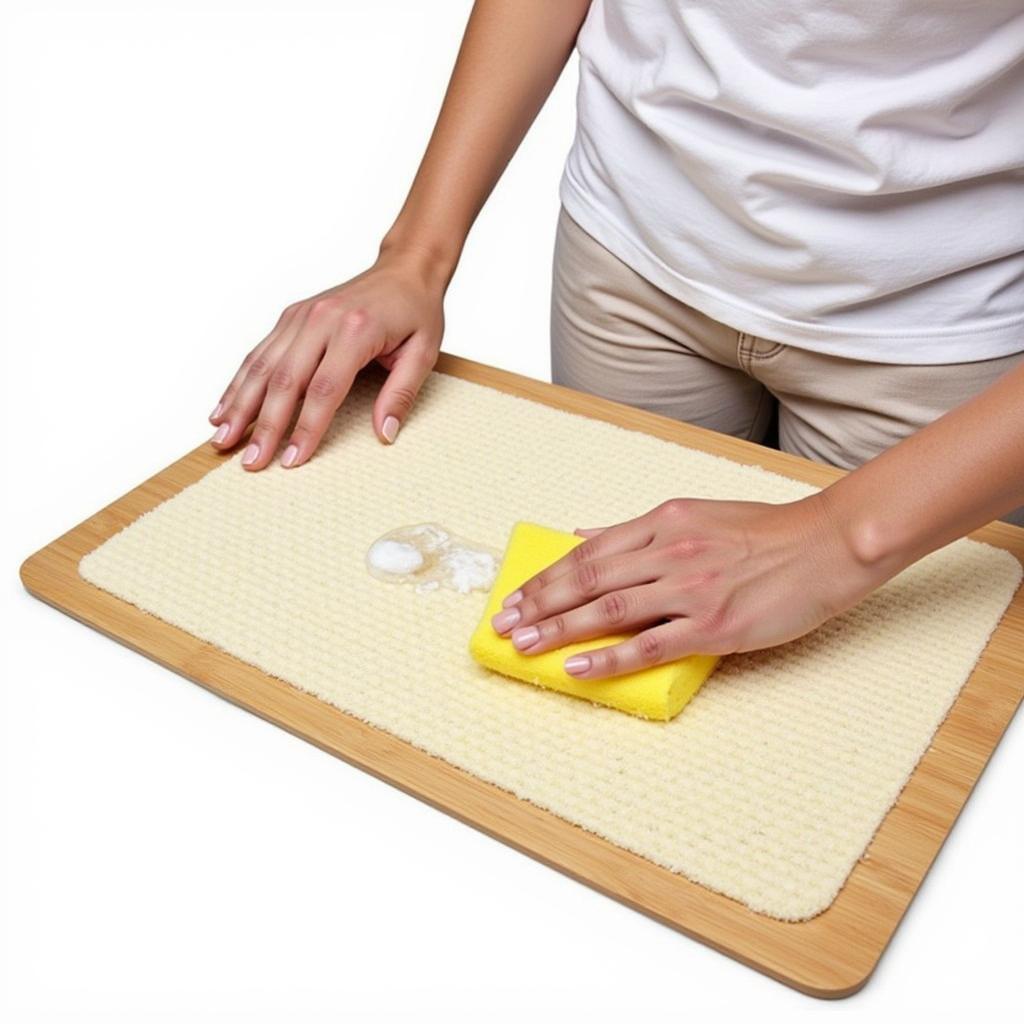Food mats have become increasingly popular in recent years, and for good reason. These versatile kitchen accessories offer a range of benefits, from protecting your countertops from spills and scratches to adding a touch of style to your culinary space. Whether you’re a seasoned chef or a casual cook, understanding the different types of food mats available and how to choose the right one for your needs can elevate your cooking experience.
Why Use a Food Mat?
 Food Mat on Countertop
Food Mat on Countertop
Food mats serve as a protective barrier between your delicate countertops and the wear and tear of daily cooking activities. They act as a shield against hot pans, sharp knives, and spills, preventing potential damage and preserving the pristine condition of your kitchen surfaces.
Beyond their protective qualities, food mats also enhance the overall aesthetic appeal of your kitchen. Available in a wide array of colors, patterns, and materials, they allow you to express your personal style and complement your kitchen decor. From minimalist designs to vibrant prints, there’s a food mat to suit every taste.
Exploring Different Types of Food Mats
The market offers a diverse selection of food mats, each with unique characteristics and advantages:
Silicone Food Mats
Silicone food mats are renowned for their exceptional heat resistance, making them ideal for placing hot pots, pans, and baking sheets. Their non-slip surface provides stability and prevents accidental spills, ensuring a safe cooking environment. Moreover, silicone mats are incredibly easy to clean, often requiring just a quick rinse or a wipe with a damp cloth.
Rubber Food Mats
Similar to silicone mats, rubber food mats offer excellent slip resistance and durability. They are particularly well-suited for use as drying mats, providing a stable platform for air-drying dishes and utensils. Rubber mats are also known for their ability to absorb shocks, reducing the risk of breakage if glassware or delicate items are accidentally dropped.
Bamboo Food Mats
For an eco-friendly and stylish option, consider bamboo food mats. These mats are made from sustainable bamboo, a fast-growing and renewable resource. Bamboo mats bring a touch of natural warmth and elegance to the kitchen. However, it’s important to note that bamboo mats may require hand washing and occasional oiling to maintain their appearance and longevity.
Choosing the Right Food Mat for Your Kitchen
Selecting the perfect food mat depends on your individual needs and preferences. Consider the following factors:
Size and Shape
Food mats are available in a wide range of sizes and shapes to accommodate different countertop spaces and kitchen layouts. Before making a purchase, measure the area where you intend to use the mat to ensure a proper fit.
Material
The material of the food mat will determine its durability, heat resistance, and ease of cleaning. Silicone and rubber mats are generally more heat-resistant and easier to clean than bamboo mats.
Style
With numerous colors, patterns, and designs available, choose a food mat that complements your kitchen decor and personal style.
Caring for Your Food Mat
 Cleaning a Food Mat
Cleaning a Food Mat
Proper care and maintenance will extend the lifespan of your food mat and ensure its optimal performance. Most silicone and rubber mats are dishwasher safe, making cleaning a breeze. Bamboo mats, on the other hand, usually require hand washing with mild soap and water. Avoid using abrasive cleaners or scouring pads that could scratch the surface of the mat.
Conclusion
Investing in high-quality food mats is a small but significant step towards creating a more organized, efficient, and stylish kitchen. Whether you prioritize heat resistance, slip resistance, or aesthetic appeal, there’s a food mat out there to meet your specific needs. By carefully considering the factors outlined in this guide, you can choose the perfect food mat to protect your countertops, elevate your cooking experience, and add a touch of personality to your culinary haven.
FAQs
Q: Can I use a food mat as a trivet?
A: Yes, many food mats, particularly those made from silicone or rubber, are heat-resistant enough to be used as trivets. However, it’s always a good idea to check the manufacturer’s instructions to confirm heat resistance.
Q: How often should I clean my food mat?
A: It’s recommended to clean your food mat after each use, especially if it has come into contact with raw meat or sticky substances.
Q: Can I cut food directly on a food mat?
A: While some food mats are designed to be cut-resistant, it’s generally not advisable to cut directly on them. Using a cutting board will help preserve the integrity of the mat and prevent potential damage.
Q: What is the best way to store food mats?
A: Food mats can be stored flat in a drawer or rolled up and secured with a rubber band. Avoid folding the mats, as this could create creases or damage the material.
For more information on related topics, check out our articles on SRA food and food grade solder. You might also be interested in our guides to dog food bowl slow feeder and slow feed dog food bowls.
Need help choosing the perfect food mat for your kitchen? Contact us at 02437655121, email us at minacones@gmail.com, or visit us at 3PGH+8R9, ĐT70A, thôn Trung, Bắc Từ Liêm, Hà Nội, Việt Nam. Our dedicated customer support team is available 24/7 to assist you.